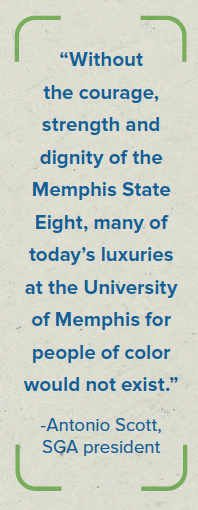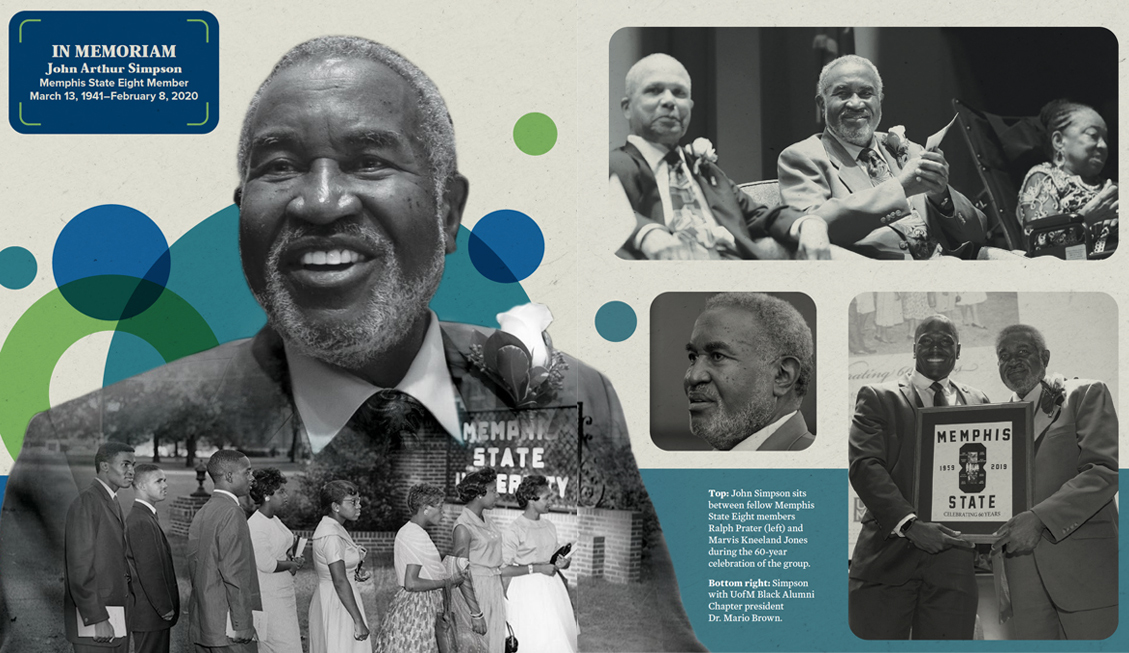UofM Magazine
By Trent Shadid
On September 18, 1959, just before 8 a.m., eight African American students were escorted to their classes on the campus of then-Memphis State University. At that moment, the group known as the Memphis State Eight began a trailblazing journey by integrating one of the most prominent institutions of higher education in the region.
The University of Memphis has grown from those eight to more than 7,000 African American students enrolled for the 2019 academic year.
The UofM celebrated Eleanor Gandy, Sammie Burnett Johnson, Marvis Kneeland Jones, Bertha Rogers Looney, Rose Blakney Love, Luther McClellan, Ralph Prater and John Simpson in September, 60 years to the day they courageously stepped on campus to begin classes for the first time. All five then-surviving Memphis State Eight members attended the 60-year commemoration — an event hosted by the Office of Multicultural Affairs, Black Alumni Council and the Department of African and African American Studies. Johnson passed away in 2011; Gandy and Love in 2017; and Simpson in February.
 “The legacy started in 1959 continues today,” said UofM Student Government Association
president Antonio Scott. “Without the courage, strength and dignity of the Memphis
State Eight, many of today’s luxuries at the University of Memphis for people of color
would not exist. They knew that others, including me, would reap the benefits.”
“The legacy started in 1959 continues today,” said UofM Student Government Association
president Antonio Scott. “Without the courage, strength and dignity of the Memphis
State Eight, many of today’s luxuries at the University of Memphis for people of color
would not exist. They knew that others, including me, would reap the benefits.”
Speaking directly to Jones, Looney, McClellan, Prater and Simpson, Scott added, “You integrated so that we may be educated, and we are forever thankful.”
Even 60 years later, the incredibly trying challenges of integration remain fresh in the memories of the Memphis State Eight. They were not allowed in the student union, cafeteria or at sporting events. They were instructed to be off campus by noon.
“I couldn’t imagine 60 years ago being able to walk on this campus and not be afraid, or having to look over my shoulder,” said Looney. “But here I stand, 60 years later, thankful for everything that has happened since.”
The Memphis State Eight were made to feel almost invisible, according to McClellan, but they persisted each day despite dealing with the emotions of being ostracized. They rarely had opportunities to interact with, or confide in, each other. In many ways, each member of the group went through the first year of campus desegregation feeling alone.
“It was my opportunity to get an education and I was not going to let that escape me,” said McClellan, who became the first African American graduate in 1962. “I just challenged myself to focus on doing my work. If another student wanted to speak to me, that was fine with me. That was my stance on it, and it worked for me. My classmates weren’t going to buck the system and become my friend, but I do think they knew that all people were created equal.”
Since 1959, the impact of the Memphis State Eight has continually grown at the University. Even the eight themselves witnessed a more diverse institution during their time on campus. After a stressful first year at the University, tensions eased as more African American students began to enroll and follow the path laid by the Memphis State Eight.
By 1970, African American enrollment had reached 2,000 students. Today that number has more than tripled, creating a University that is more diverse than ever.
At the beginning of the 2019 academic year, students who identify as African Americans accounted for 33% of the total enrollment. Over the past four years, African Americans have accounted for 30% of all degrees awarded by the UofM while all non-white ethnicities combined to account for 44% over the same time period. According to Diverse Education, the UofM is No. 13 among the top 100 producers of bachelor’s degrees earned by African Americans.

“We knew that it was going to be a challenge,” said Prater. “We knew we weren’t going to be loved or welcomed with open arms. To look out now and see so many students of color, it’s just heartwarming. It makes all of us feel like what we did was certainly worthwhile.”
African American student leadership is also thriving at the UofM. Scott and SGA vice president Desiree’ Dyson, both elected by their peers, are the third African American SGA president and vice president combination in the history of the University. Other prominent positions, including Student Activities Council president and Student Ambassador Board president, were held by African American students during 2019-20.
The progress that’s been made, and continues to be made, creating a more diverse and inclusive UofM leads back to the Memphis State Eight. They created the starting point for positive change 60 years in the making.
“I’m so pleased to see the progress that has been made over the past 60 years,” Looney said. “This college has grown so much to represent the multiculturalism that America is really about. When we come here now, we can see people from all ethnicities. I never thought 60 years ago I would see this type of diversity.”

